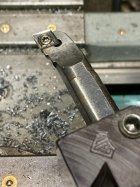There are a lot of different ways to approach chambering and virtually all can work. There are a number of factors which might influence the choice of method. Primary among these is the straightness of the barrel. Most good barrels are pretty straight; rare barrels are near perfect. I'm fitting one now, from Hugh Williamson, which is exceptionally straight, and is a treat to work with.
On my YT channel, I try to show various methods for doing things (using old, ratty, equipment and little in the way of skill) and on this one, I decided to show setting up between centers to thread and in the steady for chambering.
Now, "back in the day", it was commonplace to grab the barrel in the three jaw chuck, face it, ream a center with a piloted center reamer, grab it at the muzzle (again with the three jaw), support the breech end on the tailstock center to true the shank and cut the threads, then mount the steady rest to support the barrel for chambering. To a large extent, this was done for the sake of expedience, and it worked OK. In fact, with just a little care and a straight barrel, it was fine. And it was quick. I could complete a half dozen rifles in an eight hour day (fit, chamber, cut and crown, cut extractor cut if required, polish and bead blast).
For this Williamson barrel, I didn't take quite so cavalier of an approach, because I didn't want to compromise the job at all. So, I dialed in both ends of the barrel to ream the centers so that, on the breech the runout was zero and at the muzzle it was .0003TIR. From there, I went ahead and set up between centers to thread and true the shank, then set up in the steady to chamber. In the steady, running on the shank, runout of the bore was still zero. I roughed the chamber with a common twist drill, which drilled right on size and produced a hole with less than .0002 TIR. So, in this particular instance, this method will work about as well as any; largely because I took great pains with the centers and because the barrel is so straight. If the barrel had shown a significant amount of curvature, or if I had seen any runout at any point, I would have had to set up differently to deal with that.
My whole point is; any method CAN work, if everything is right. It's when not everything is right that you might have to adapt a little to meet the circumstances.
By the way, I'm sure I've mentioned it before but, if your tailstock center sits high, run the machine for long enough to warm the headstock up well, then check it again. WH












